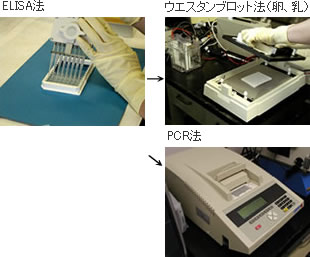Here's the text.
Testing for allergic substances
Last Updated April 1, 2023
Inspection of foods containing allergic substances
In November 2002, the Ministry of Health, Labour and Welfare issued a notification on the inspection methods for foods containing allergic substances, and has been revised several times to date. This method is considered to be the most reliable at this time to check whether processed foods contain specific raw materials.
However, the test results of allergic substances using this test method may not always match the actual content accurately due to the denaturation and decomposition of proteins due to processing such as heating, pressurization, and fermentation, as well as the extraction efficiency at the time of inspection.
Inspection method
1 Screening Test
For specific raw materials, a test kit using the ELISA method, which specifically responds to allergic substances, is commercially available, and screening tests are performed using these. The ELISA method (Enzyme Linked ImmunoSorbent Assay Enzyme Immuno Sorbent Assay Enzyme Immuno Method) uses antigen antibodies to measure trace amounts of substances to detect and quantify proteins derived from specific raw materials in food.
2 Confirmation inspection
If the screening test is positive, the egg and milk will be tested by Western blot method. Western blotting is a method of using electrophoresis and antigen antibody reactions to check if specific proteins are contained.
Wheat, buckwheat, peanuts, shrimp, and crabs are checked by the PCR method. The PCR method (Polymerase Chain Reaction polymerase chain reaction) is a method of amplifying and confirming whether a specific DNA (gene) is contained.

Test results up to now
We have been testing allergic foods since fiscal 2003.
As a result of the inspection, two cases were violated in FY2017 and one case in FY2008.
Two cases in FY2017 (soba, rice crackers) were labeled violations due to omission of raw materials (wheat), and one case in FY20 (Chikuwa) was produced without eggs so that even people with egg allergies could eat it. However, it was due to incorrectly adding eggs to raw materials.
Test results of allergic foods
| Number of inspections | ||||||||
|---|---|---|---|---|---|---|---|---|
| Fiscal year | Egg | Milk | Wheat | Soba | Peanut | Shrimp crab | Total | Number of Violations |
| 2003 | 16 | 16 | 16 | 16 | 7 | - | 71 | 0 |
| 2004 | 24 | 18 | 16 | 8 | 8 | - | 74 | 0 |
| 2005 | 24 | 24 | 24 | 0 | 0 | - | 72 | 2 (Wheat) |
| 2006 | 56 | 16 | 0 | 0 | 0 | - | 72 | 0 |
| 2007 | 32 | 8 | 48 | 0 | 0 | - | 88 | 0 |
| 2008 | 31 | 16 | 56 | 0 | 8 | 0 | 111 | 1 (Egg) |
| 2009 | 46 | 32 | 0 | 0 | 0 | 24 | 102 | 0 |
| 2010 | 99 | 13 | 8 | 0 | 0 | 8 | 128 | 0 |
| 2011 | 72 | 29 | 23 | 8 | 0 | 8 | 140 | 0 |
| 2012 | 83 | 34 | 33 | 0 | 0 | 0 | 150 | 0 |
Inquiries to this page
RIKEN, Medical Care Bureau Institute of Hygiene
Telephone: 045-370-9451
Telephone: 045-370-9451
Fax: 045-370-8462
Email address: ir-eiken@city.yokohama.jp
Page ID: 260-459-470







